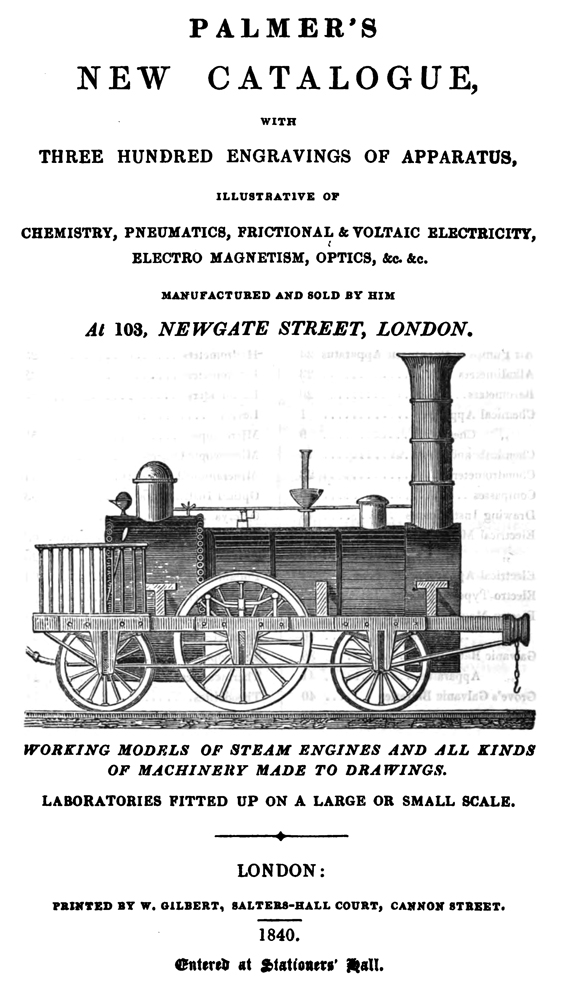
Figure 1. Cover of Edward Palmer’s 1840 catalog.
Edward Palmer, 1803 - 1872
by Brian Stevenson
Last updated October, 2017
Edward Palmer was a relatively minor figure in microscopy. He operated a natural philosophy (i.e. scientific) shop in London during the 1830s-40s. He was probably the master with whom William Henry Thornthwaite served his apprenticeship (Thornthwaite later formed the optics company of Horne, Thornthwaite and Wood). But Palmer is included in this series of biographical essays because he issued an extensive catalog of his wares in 1840, which is presently the earliest identified, freely-accessible sales catalog of microscopical apparatus (available from Google Books, and from links on this web site). Palmer’s catalog provides important insights into what sorts of microscopes and other items were available to scientifically inclined Englishmen during the early Victorian era.

Figure 1. Cover of Edward Palmer’s 1840 catalog.
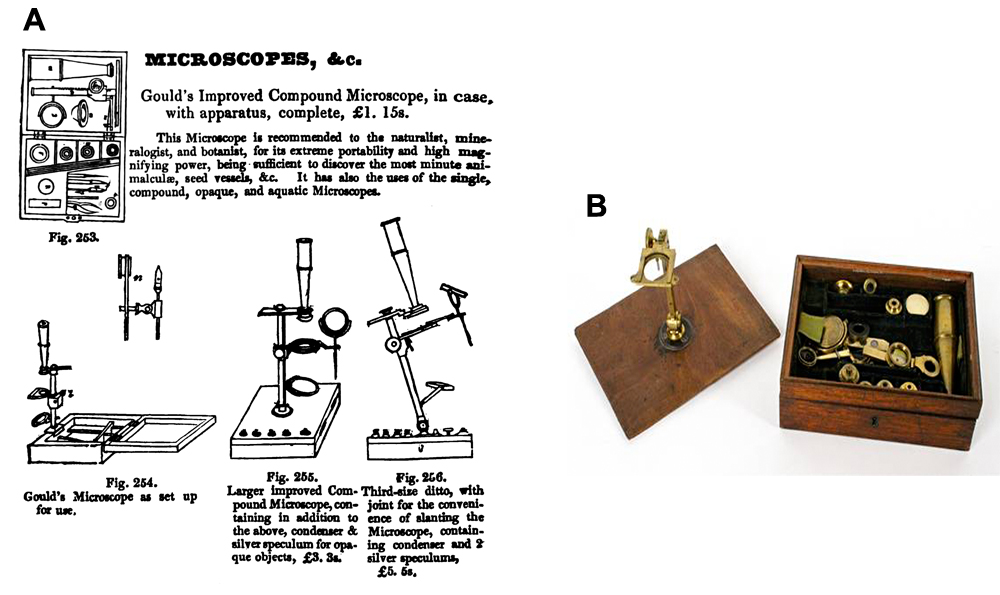
Figure 2.
(A) The
first page of microscopes listed in Palmer’s catalog, all of the type designed
by Charles Gould. The inclusion of Gould’s name here suggests that he was the
actual maker of these instruments. Gould was working for William Cary in the
mid-1820s when he designed the type of microscope labeled ‘Fig. 254’, and these
types of microscopes are often called “Cary”. Palmer’s catalog indicates that,
by 1840, one could purchase the original Gould-type microscope, in which the
microscope mounted to the inside of the box (fig. 254), or larger microscopes
that mounted to the center of the wooden box, without or with a hinge for tilting
the instrument (figs. 255 and 256, respectively). William Cary died in 1825,
and, although Cary’s nephews inherited the business, Gould managed
the operation. In ‘The Great Age of the Microscope’, G. Turner hypothesized
that a single factory may have produced many or all Gould-style microscopes –
Palmer’s catalog suggests that this may have been the Cary-Gould enterprise.
Gould’s book, ‘Companion to the Microscope’, was written to accompany his
microscopes. Palmer’s figures 253 and 254 were adapted from illustrations in
Gould’s book. (B) A Gould-style
microscope engraved ‘Edward Palmer’, sold in 2010 by Bonham’s auctioneers. This is a “third-size” microscope with a joint, as illustrated by Palmer in his figure 256.
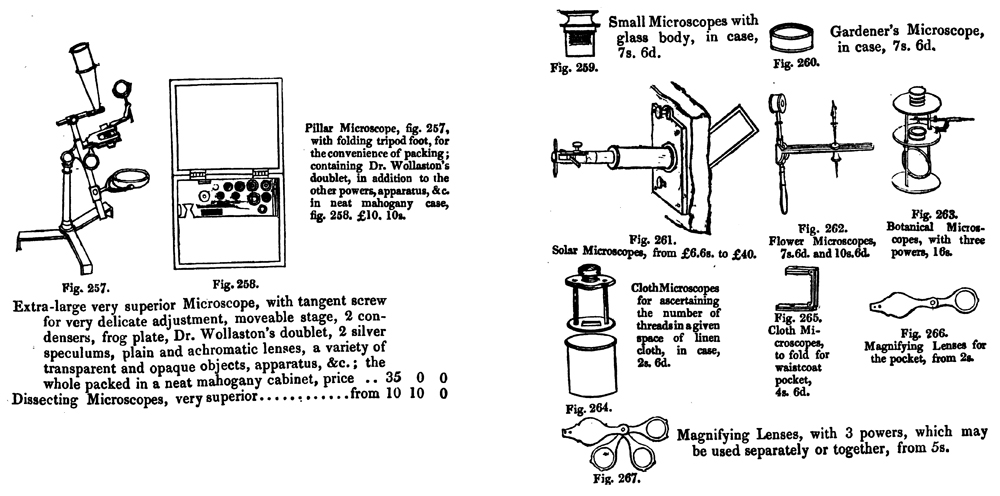
Figure 3. The other microscopes offered in Palmer’s catalog,
ranging from single-lens magnifiers to complex compound microscopes. Note that
the ‘extra-large very superior microscope’ cost £35, placing it well beyond the
reach of the vast majority of people in 1840.
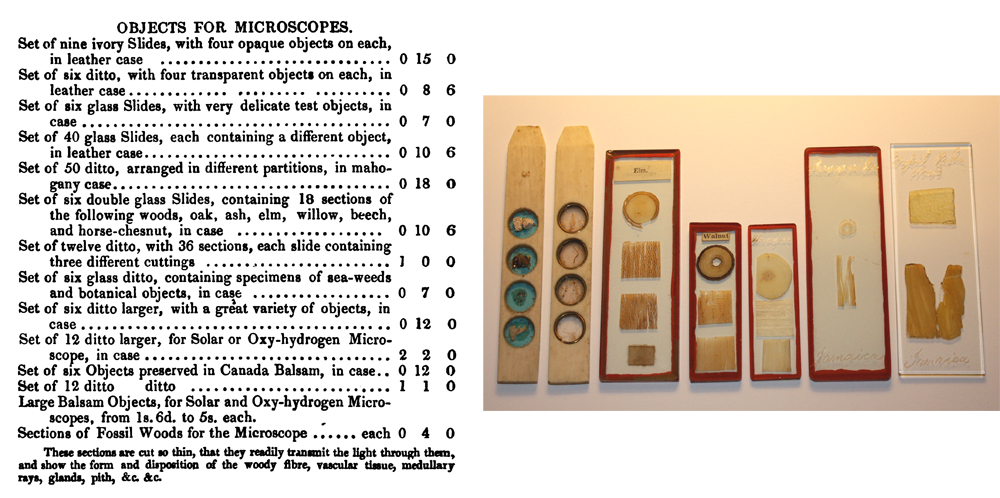
Figure 4.
The list of microscope slides offered by Palmer in
1840. The photograph shows examples that correspond with Palmer’s descriptions
(please note that there are no indications that any of these examples was
retailed by Palmer). Left to right: ivory slide with four opaque objects, ivory
slide with four transparent objects, double glass slide containing three
sections of elm wood, two double glass slides containing three each sections of
wood, double glass slide containing botanical objects (sarsaparilla), and a slide
of sections of fossil wood. The double glass slides, sealed with red wax, are
nowadays often attributed to Andrew Pritchard because he described their
production in a 1847 book, and because such slides are occasionally found with
Pritchard’s name attached. However, there is no evidence that Pritchard
actually made any of these slides, nor that he was the only retailer to have
sold them. John Quekett, in his ‘Treatise on the Use of the Microscope’ stated
that these slides were made by William Darker. A detailed biography of William Darker and his extensive
involvement with early microscopy and optics is currently under production.
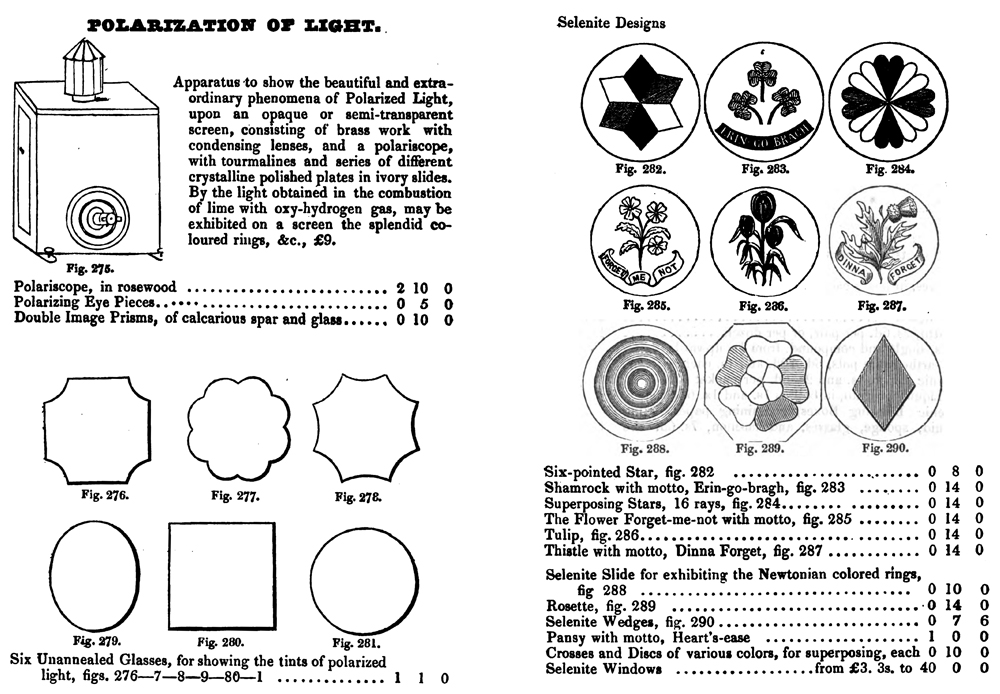
Figure 5.
Palmer’s offerings for the study and enjoyment of
the effects of polarized light. All of these items may have been produced by
William Darker, who was renowned for his polarizing and projecting microscopes,
and “a great variety of devices prepared with films of selenite of different
thicknesses, and which constitute philosophical toys .. Gothic windows, stars,
flowers, fruits, animals (butterflies, parrots, dolphins and chameleons), and
theatrical figures (Jim Crow, harlequin, &c.), are some of the ingenious,
and often laughable illustrations contrived by Mr. Darker” (Pereira).
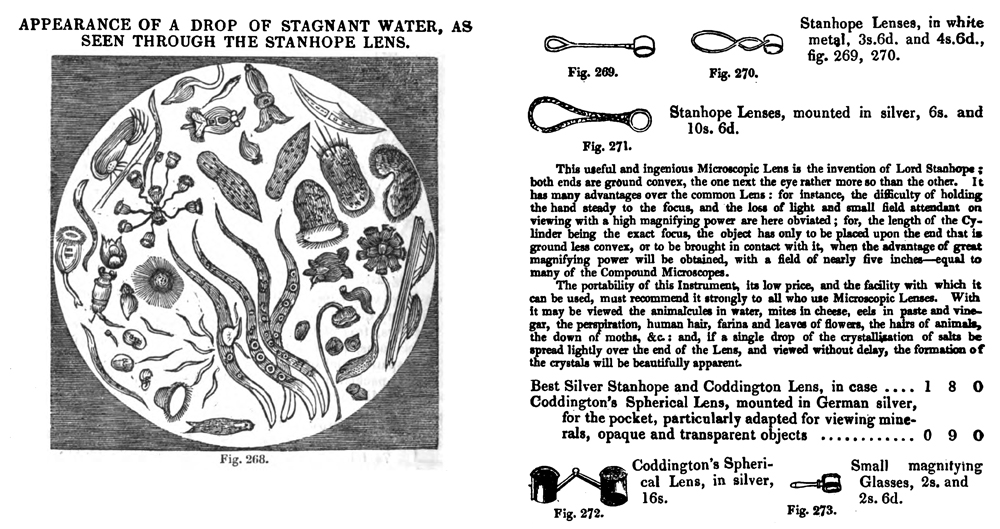
Figure 6.
Stanhope and other small magnifying glasses offered
by Palmer.
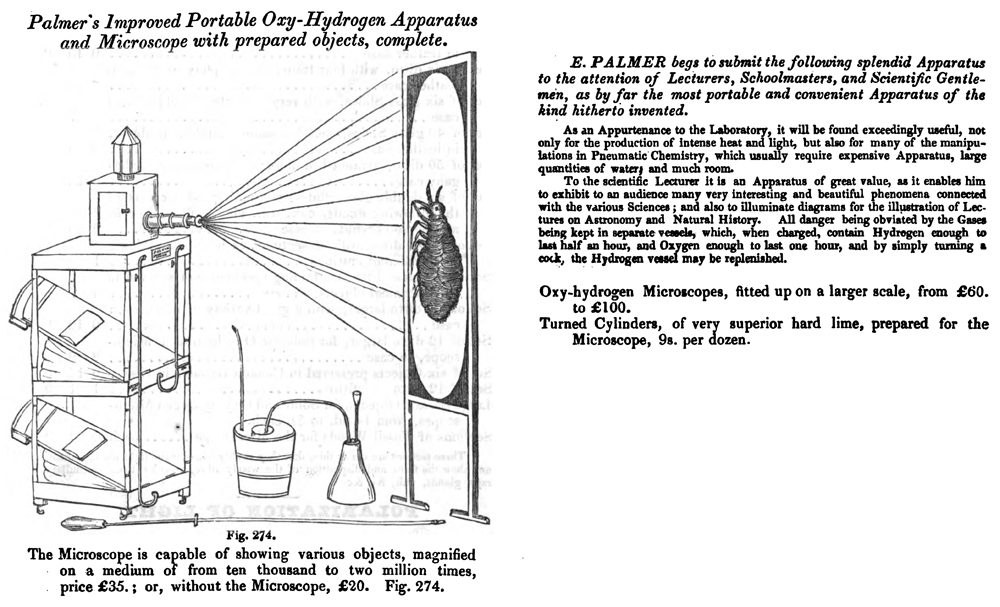
Figure 7.
Projection microscopes offered by Edward Palmer.
These burned hydrogen gas in the presence of pure oxygen, which produces a very
intense light.
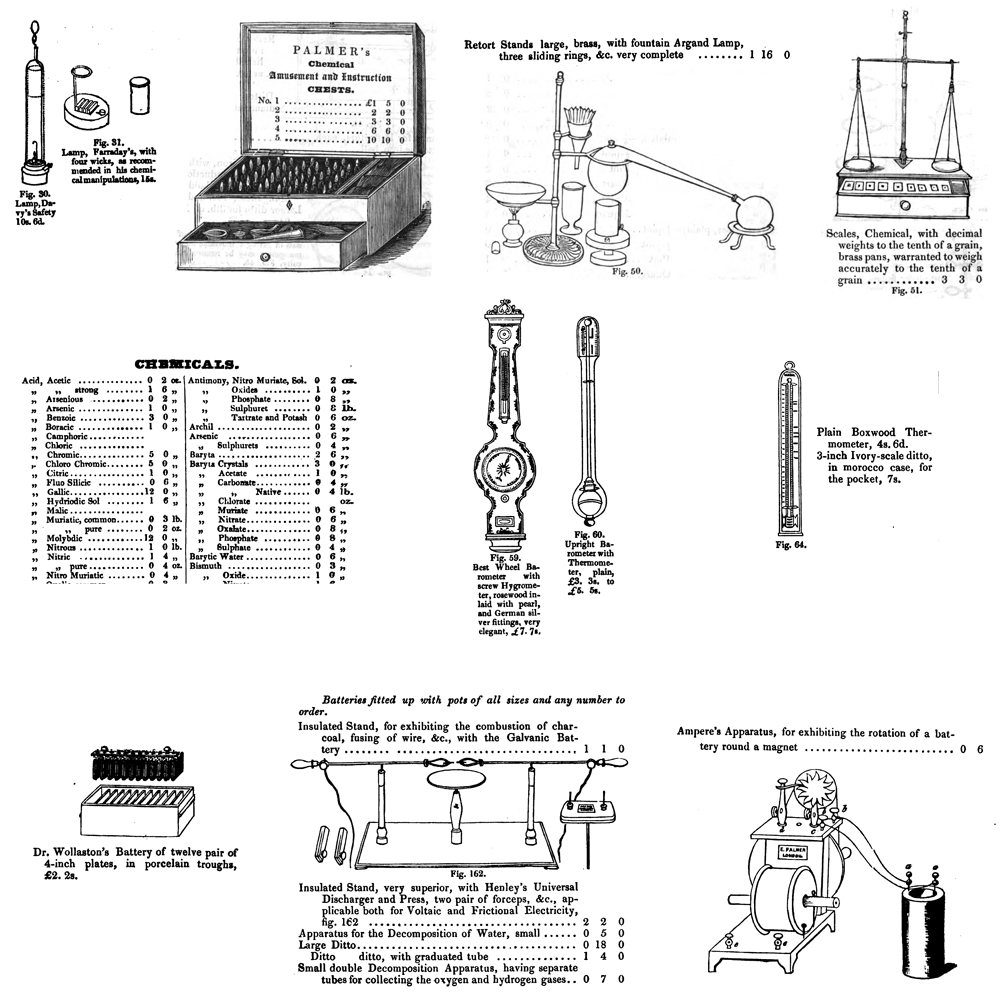
Figure 8.
Some other types of items offered in the 1840 Palmer
catalog. A wide variety of instruments, chemicals, etc. were sold to meet
virtually every scientific or engineering need.
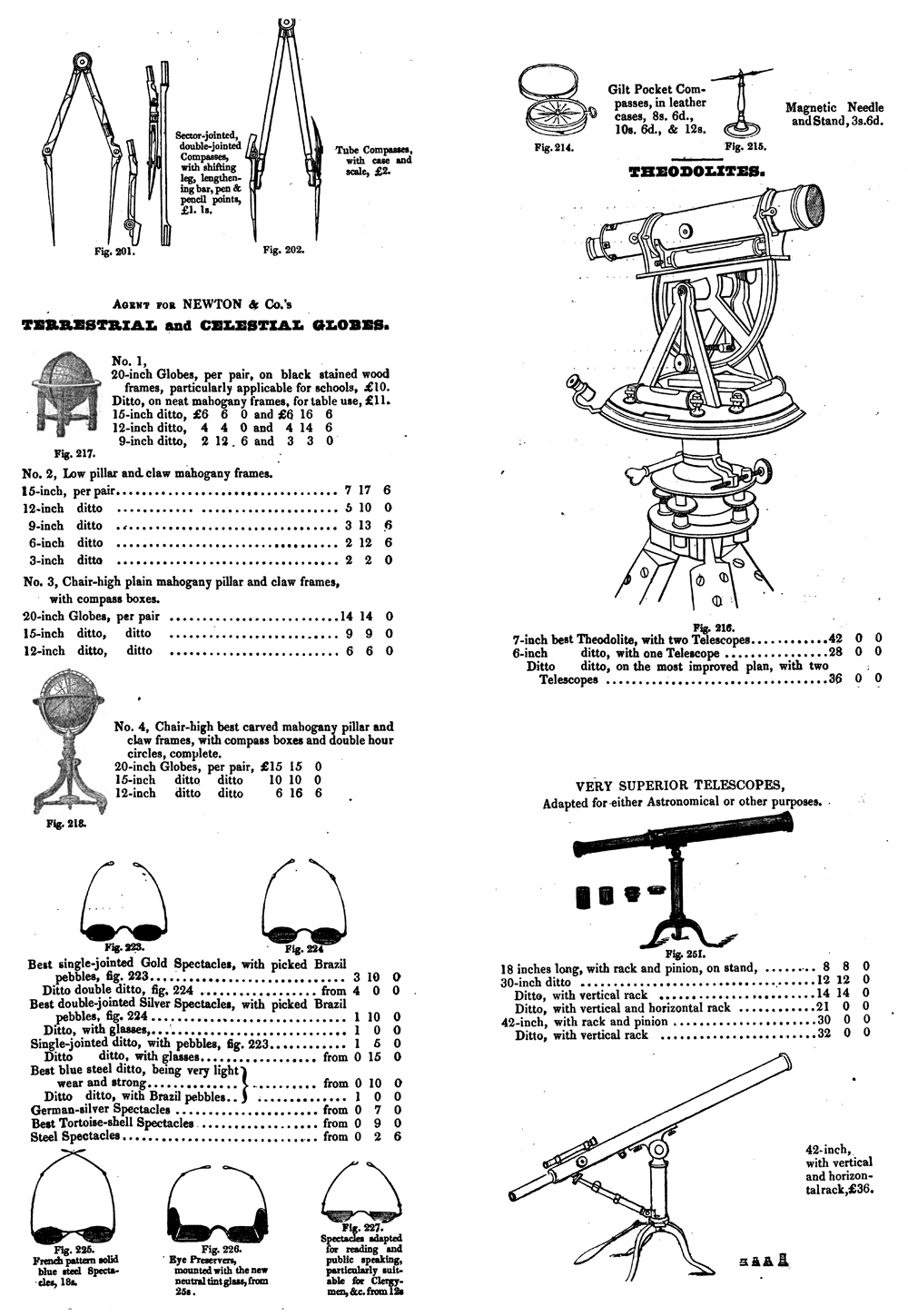
Figure 9.
Further items available from Edward Palmer.
Edward Palmer was born July 1, 1803, in the parish of St. Bartholomew-by-the-Exchange, Middlesex (London). He was the eldest child of Edward and Elizabeth Palmer. The father was a wholesale druggist and chemist, and partner in the firm of Fynmore and Palmer of 62 Aldersgate Street, and later of 31 Throgmorton Street, London.
At some point, Edward moved south, across the Thames, to Southwark. He lived in the parish of St Olave Southwark during 1828, when he married Jemima Closs Law. The 1830 christening record of their only child, also named Jemima, reported that the Palmers then lived in St. Giles Southwark. The christening record also stated that Edward worked as a “chemist”, a trade that he presumably learned from his father. Later records indicate that Palmer was skilled at fine machine work, although it is not known where he acquired that art.
�In 1837, Palmer had established a business at 103 Newgate St., London, dealing in “Chemical and Philosophical Apparatus, Microscopes, &c.” (Figure 10A). Electrical and magnetic devices sold by Palmer (Figure 10B) were probably made by him. A series of advertisements that appeared in the 1839 Athenaeum promoted “pneumatic filtering machines”, whereby one could filter and concentrate “liqueurs, wines, essences, &c. with a rapidity perfectly astonishing. The concentrated essence of coffee, produced by this unequalled process, surpasses anything of the kind in flavour”.
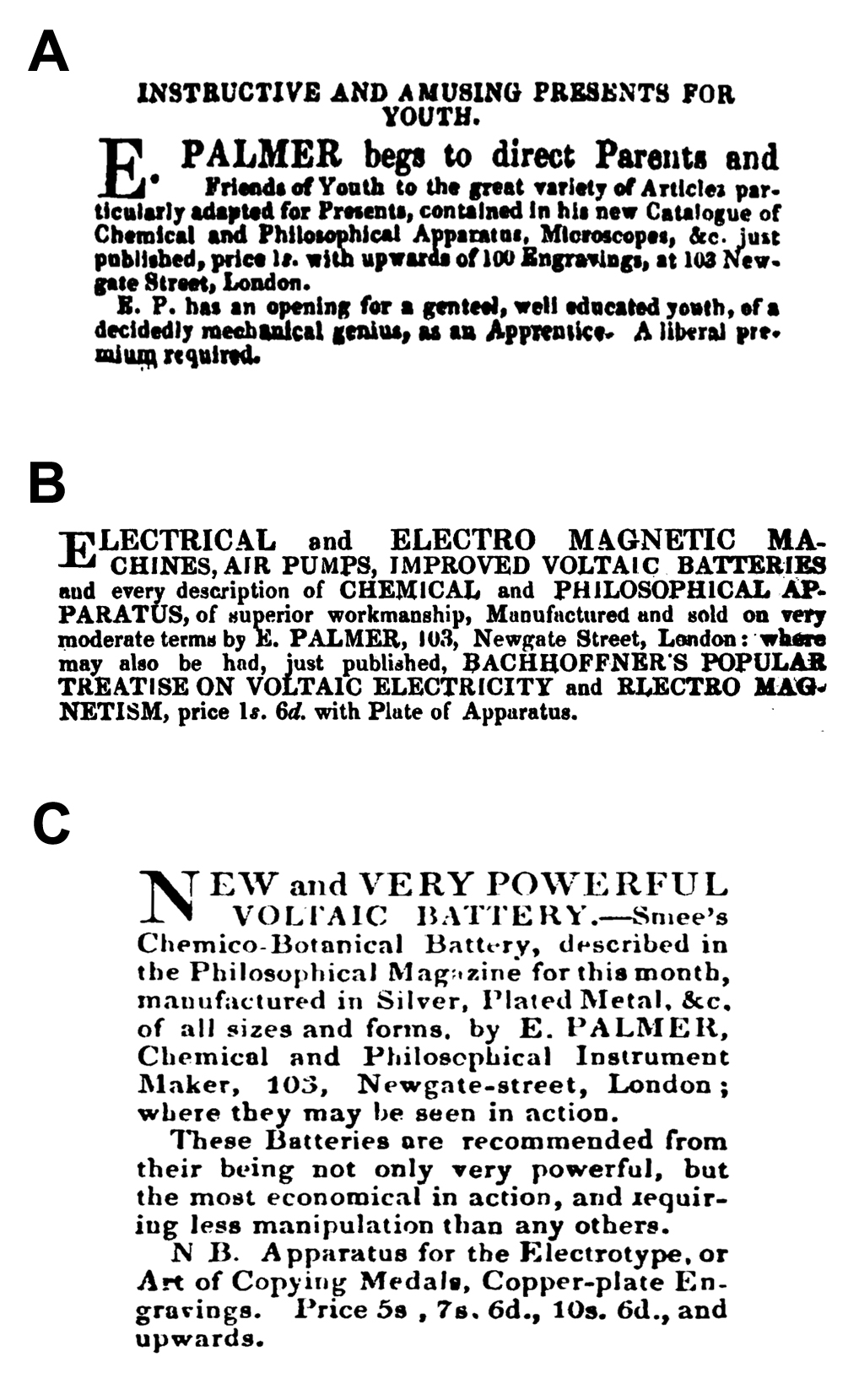
Figure 10.
Advertisements from Edward Palmer that appeared in
(A) ‘The Literary Gazette”, December 15, 1837,
(B) ‘Arcana of Science and Art’, published early 1838, and
(C) ‘The Edinburgh Review’, April, 1840.
Note that Palmer also advertised in 1837
for an apprentice. The 1841 census recorded the Palmers sharing their home on
Newgate with 15 year-old “shop boy” William Bolton. He is probably the same
person who later operated his own photographic supply shop in London. In 1841,
103 Newgate was also home to “chemical and philosophical instrument makers”
William Thornthwaite and Thomas Willatts, both approximately 20 years old (the
1841 census rounded off ages to 5 or 10 years) and who probably had also
apprenticed with Palmer.
On June 12, 1841, “Edward Palmer, of Newgate-street, gentleman”, was awarded a patent for “improvements in producing printing surfaces, and in the printing china, pottery, ware, music, maps, and portraits”. These were advances in electroplating/electrotyping, and is indicative of Palmer’s skills in engineering and electronics. He elaborated on this in the following 1840 advertisement, “ELECTROTYPE; or, the Art of Procuring, in the most simple manner, by means of Galvanic Action, perfect Facsimiles of engraved Copper-plates of all sizes, even of the most elaborate workmanship; also correct copies of Medals, and all kinds of Metallic Ornaments; specimens of which may be seen, and the Apparatus had, of all sizes, of E. PALMER, Philosophical Instrument Maker, 103, Newgate-street, London. Prices 5s., 7s. 6d., 10s. 6d., and upwards”. The figures for Palmer’s 1840 catalog were probably made by this method, as indicated by another 1840 ad, “THREE HUNDRED ENGRAVINGS of Apparatus illustrative of Chemistry, Pneumatics, Friction, and Voltaic Electro-Magnetism, Optics, &c. &c, embracing many new and valuable instruments of research and amusement, are now publishing by E. PALMER, 103, Newgate-street., London, in his new printed Catalogue for 1840. Price 1s. 6d., to be had of all Booksellers”.
Palmer sold electrotyped pictures, equipment for producing electrotypes, and books on electrotyping. He also printed books, probably using electrotype. Some announcements and reviews follow:
ELECTROTYPE.—JOHN KNOX REPROVING MARY QUEEN OF SCOTS, by J. Burnett. E. PALMER having electrotyped the above splendid and highly interesting engraving, Prints, both of the original and electrotyped plates may now be had, price 21s. each at his Optical and Philosophical manufactory, 103, Newgate-street, London.—Engravers and Publishers furnished with copper duplicates of their engraved plates. (The Art Union, 1841)
ELECTROTYPE. — Just Published, by E. PALMER, 103, Newgate-street, and Longman and Co., Paternoster-row, ELEMENTS OF ELECTROMETALLURGY, OR THE ART OF WORKING IN METALS BY THE GALVANIC FLUID; containing the laws regulating the reduction of the Metals; the states in which the deposit may take place; the apparatus to be employed ; and the application of Electro-Metallurgy to Manufactures; with minute description of the processes for Electro-Gilding, Plating, Coppering, &c.; the method of etching by Galvanism; the art of working in Gold, Silver, Platinum, and Copper; with full directions for conducting the Electrotype. Illustrated with Woodcuts. By A. Smee, Esq., Surgeon to the Bank of England, &c. Price 10s. 6d., elegantly bound in cloth, gilt edges. (The Art Union, 1841)
THE FIRST PART of a Series of ILLUSTRATIONS of the ART of ELECTROTYPE, as applicable to the multiplication of engraved plates of the most delicate and elaborate workmanship, intended as an accompaniment to "Smee's Elements of ElectroMetallurgy,'' containing a variety of Specimens in Line and Chalk, both from Copper and Steel plates, the Originals by Finden, Heath, Robinson, Miller, and others. Published by E. Palmer, 103, Newgate-street, London; and Longman & Co. Paternoster-row. N. B. — Engravers and Publishers furnished with duplicates of their Plates of all sizes, by E. Palmer as above. (The Art Union, 1841)
Electrotint; or, the Art of making Paintings in such a manner that Copper Plates and " Blocks" can be taken from them by means of Voltaic Electricity. By Thomas Sampson. Palmer. 103, Newgate-street. This is a short pamphlet published by Mr. Palmer, in explanation of his process of Electrotint painting. The discovery is a valuable one, since it enables the artist to infuse into the copper plate his own touch and feeling without the mediate assistance of a copier; and we cannot doubt, that an art presenting so great advantages as that of Electrotint will speedily arrive at an increased state of perfection. The printing surfaces it produces are either raised or sunken: each is explained; and the pamphlet contains technical directions concerning brushes, tools, plates, handling, &c. for the use of artists in Electrotint, or of such chemists as may desire to amuse themselves by practising, as a matter of curiosity, this new application of the powers of voltaic electricity. To these we recommend it as an indispensable assistant. The specification of the patent is appended, containing a concise description of the invention, and the mode in which it is applied. (The King's College Magazine, 1841)
GLYPHOGRAPHY; or, Engraved Drawings, by which Books may now be Illustrated in a very superior manner, securing to Artists a faithful copy of their Designs to the minutest touch, and at a very great saving of expense, the Drawings being transferred to Surface Printing Blocks, which are printed like Wood Cuts, with the Type. The most elaborate Drawings can, by these means, in a few days, be made ready for the Press. A great variety of Specimens may be seen, and every information afforded to Authors, Publishers, and Artists, on personal application to the Patentee at 103, Newgate-street, London, between 9 & 10 o'clock, a.m.— N.B. A little Work, descriptive of the process, and containing full directions for Artists with Illustrations, is in the Press, and will shortly be published, price 1s. 6d. By E. Palmer, 103, Newgate-street, London. (£.S.D., 1843)
Photographic Manipulation, price 1s. 6d., containing simple and practical details of the most improved processes of Photogenic Drawing, Daguerreotype, and Calotype, illustrated with Cuts. Just published by E. Palmer, 103, Newgate-street, London, where may also be had all the apparatus and chemicals required for carrying out these interesting and valuable discoveries. (Mechanics Magazine, 1843)
In August, 1844, Palmer closed his business and sold off his stock (Figure 11). The bulk of his goods was acquired by Fallon Horne, William Henry Thornthwaite, and Edward George Wood, all of whom described themselves as long-term employees and suppliers (Figure 11). Thornthwaite was the author of Photographic Manipulation (described in the preceding paragraph), which was one of the first books to be published on photography. The first edition was published by Palmer in 1843 without naming the author. The second edition, also published by Palmer in 1843, gave authorship credit to Thornthwaite. The company of Horne, Thornthwaite, and Wood (later Horne and Thornthwaite) produced microscopes, photographic equipment, and other optical apparatus and supplies until 1911.
Edward Palmer was only 42 when he sold the business at 103 Newgate. For the 1851 census, he described his occupation as being an “auctioneer and estate agent”, with he, Jemima, and their daughter living in Clerkenwell, Middlesex. In 1861, Edward was a “commercial traveller” (traveling salesman), and he and his wife lived in Islington, Middlesex. Edward and Jemima were retired on annuities by 1871, and lived with their daughter, her husband, and their 6 children in Leeds, Yorkshire. Edward Palmer died in Leeds late in 1872, at the age of 69.
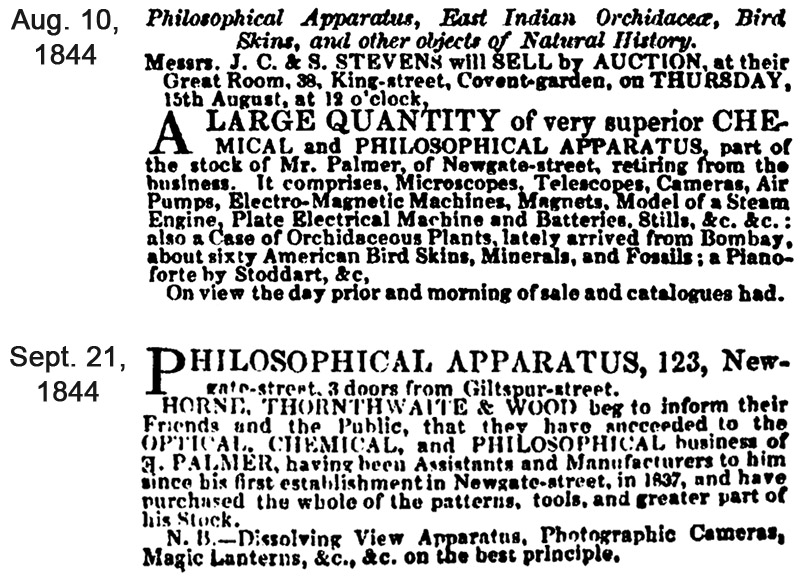
Figure 11.
Advertisements from 1844 issues of The Athenaeum. The August 10 advertisement announced the auctioning-off of Edward Palmer's goods, while the September 21 advertisement announced the opening of Horne, Thornthwaite, and Wood, as successors to Palmer.
Acknowledgements
My thanks to Julie Clulow for sharing information on Palmer’s early life, and to Howard Lynk for our ongoing, productive conversations on historical microscopy.
Resources
Arcana of Science and Art for 1837 (1838) Advertisement from E. Palmer, rear of the book
The Art Journal (1840) Advertisements from E. Palmer, Vol. 1, page 84
The Art Union (1841) Advertisements from E. Palmer, Vol. 3, pages 2, 39 and 98
The Athenaeum (1838) Advertisements from E. Palmer, pages 288, 383, 442, 879, 911 and 991
The Athenaeum (1844) Advertisement from Horne, Thornthwaite, and Wood, page 865
The Athenaeum (1854) Advertisement from William Bolton, Nov. 11, page 921
Bachhoffner, George H. (1838) A Popular Treatise on Voltaic Electricity and Electro-magnetism, Simpkin and Marshall, and E. Palmer, London
Bonham’s Auction web site (accessed June, 2011), Lot 203: An Edward Palmer Gould-type microscope, English, 1838-45, http://www.bonhams.com/eur/auction/18148/lot/203/#
Christening record of Edward Palmer (1803) St. Bartholomew Exchange, accessed through familyhistory.org
Christening record of Jemima Closs Law (1804) St. Giles Camberwell, accessed through familyhistory.org
Christening record of Jemima Palmer (1830) St. Giles Camberwell
The Civil Engineer and Architect’s Journal (1841) List of new patents, Vol. 4, page 248
Early Photography (accessed June, 2011) Horne, Thornthwaite and Wood, http://www.earlyphotography.co.uk/site/companies1.html#hornethornthwaite
The Edinburgh Review (1840) Advertisements from E. Palmer, Vol. 71, pages 35 and 39
English birth, christening, marriage, death and census records, accessed through ancestry.co.uk
Gould, Charles (1829) The Companion to the Microscope, sixth edition, W. Cary, London (download book) (55 MB)
Historic Camera (accessed June, 2011) Horne, Thornthwaite and Wood, http://www.historiccamera.com/cgi-bin/librarium/pm.cgi?action=display&login=htw
The London Journal of Arts and Sciences (1841) Review of Elements of Electro Metallurgy by Alfred Smee, Vol. 17, pages 381-383
The King’s College Magazine (1841) Review of Electrotint; or, the Art of making Paintings in such a manner that Copper Plates and "Blocks" can be taken from them by means of Voltaic Electricity by Thomas Sampson, Vol. 2, page 167
The Literary Gazette and Journal of Belles Lettres, Arts, Sciences, &c. (1837) Advertisement from E. Palmer, Dec. 15, Issue No. 1143, page 798
Marriage record of Edward Palmer and Jemima Closs Law (1828) St. Giles Camberwell
Mechanics’ Magazine (1843) Advertisement for Photographic Manipulation, published by E. Palmer, page 521
Palmer, Edward (1838) A Catalogue of Electro-magnetic and Voltaic Apparatus, Manufactured by Edward Palmer, Philosophical Instrument Maker, 103, Newgate Street, London, J. Nichols, London (download)
Palmer, Edward (1840) Palmer’s New Catalogue, printed by W Gilbert, London (download)
The Penny Mechanic and Chemist (1841) Answers to queries, pages 207, 352, 392 and 440
Pereira, Jonathan (1854, 1st edition written in 1843) Lectures on Polarized Light, 2nd edition, Longman, Brown, Green and Longmans, London, pages x, 60 and 135-136
£. S. D., or, Accounts of Irish Heirs Furnished to the Public (1843) Advertisement section
Publisher’s Circular and Bookseller’s Record (1844) Advertisement for Glyphography, published by E. Palmer, page 141
Quekett, John (1848) Practical Treatise on the Use of the Microscope, first edition, Bailliere, London, pages 289-290 (Mr. Darker’s method)
Quekett, John (1852) Practical Treatise on the Use of the Microscope, second edition, Bailliere, London, pages 317-318 (Mr. Darker’s method), and 403-404 (mounting wood sections)
Sampson, Thomas (1842) Electrotint; or, the Art of Making Paintings in such a Manner that Copper Plates and "Blocks" can be taken from them by Means of Voltaic Electricity, E. Palmer, London
Sidney, Edwin (1843) Electricity: its Phenomena, Laws and Results, Religious Tract Society, London, preface and pages 20-21
Stevenson, Sara, Julie Lawson, Michael Gray (1988) The Photography of John Muir Wood 1805-1892, Scottish National Portrait Gallery, Edinburgh, page 23
Thornthwaite, William H. (1845) A Guide to Photography, R. Groombridge and Sons, London, especially pages 69-71
Thornthwaite, William H. (1843) Photographic Manipulation, second edition, E. Palmer, London
Turner, Gerard L’E. (1989) The Great Age of the Microscope, IOP Publishing, Bristol, pages 75-85